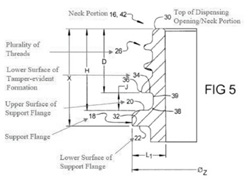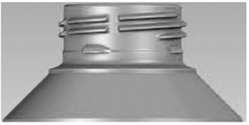The US Court of Appeals for the Federal Circuit, citing a dispute as to material facts, held that a factfinder could reasonably conclude that an alleged joint inventor failed to sufficiently contribute to inventing the claimed technologies and thus reversed a district court order granting summary judgment of invalidity based on failure to join an inventor. Plastipak Packaging, Inc. v. Premium Waters, Inc., Case No. 21-2244 (Fed. Cir. Dec. 19, 2022) (Newman, Stoll, Stark, JJ.)
Plastipak sued Premium Waters, asserting 12 patents directed in part to the neck portions of lightweight plastic containers and preforms. These neck portions include a dispensing opening, a tamper-evident formation (TEF) that indicates if the container has been opened and a support flange/ring to facilitate manufacturing handling:

The patents list Richard Darr and Edward Morgan as inventors. Premium Waters countered that the patents should have included a third co-inventor, Alessandro Falzoni, an employee of another company with whom Darr and Morgan had collaborated on a project involving a design that included a neck portion, a specialty closure and a discontinuous TEF. Premium Waters moved for summary judgment of invalidity on the theory that the failure to include Falzoni as a joint inventor rendered the patent invalid, contending that Falzoni contributed the following to the invention:
- A discontinuous (as opposed to continuous) TEF that is claimed by five of the asserted patents
- A neck portion with only 0.580 inches or less separating its dispensing opening from its support flange/ring’s lower surface (the X dimension, as shown in the diagram above) that is claimed by the other asserted patents.
Plastipak contended that the asserted inventors were the sole inventors and that discontinuous TEFs (Falzoni’s alleged contribution) were merely state-of-the-art.
In granting the motion for summary judgment, the district court observed that Falzoni was “at least” a joint inventor because he had disclosed to one of the named inventors a neck finish measuring less than 0.580 inches with a discontinuous TEF in the form of an image of a 3D model that “constituted clear and convincing evidence of Falzoni’s disclosure, leaving ‘no doubt’ that the image ‘contributed significantly to the conception of a complete neck finish.’”

That model’s support ring lacked a lower surface, however, and Plastipak argued that without a lower surface the 3D model’s X dimension was undeterminable.
Plastipak also argued that Falzoni’s email circulating the 3D model stated that “[t]he area below the neck support ring has been left undefined” and seemingly invited the named inventor (Darr) to finalize it. Darr did so and, on the same day, emailed Falzoni a schematic depicting a support ring with a lower surface and a 0.591-inch X dimension.
Falzoni testified that while he calculated that the model had a ~0.563-inch X dimension, that calculation was based on “a reasonable indication” of where the support ring’s lower surface should be, and that the absence of an [...]
Continue Reading
read more

 Subscribe
Subscribe


